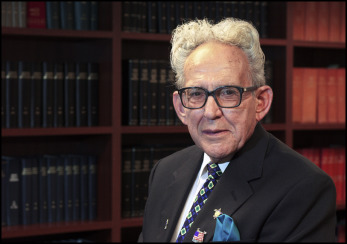
If someone asked Dr Gus G. Sotiropoulos when he was born he would say “February 26, 1926,” and then quickly add “ ad .” He died on June 12, 2015 ad , at the age of 89. He had a great run…as a professional and as a person.
Dr Sotiropoulos, known to many as “Dr Gus,” received his dental education at Saint Louis University (SLU), graduating in 1950, and his orthodontic certification at the same institution in 1952. He practiced orthodontics with his brother, Dr Peter Sotiropoulos, in Belleville and East Saint Louis, Illinois, for 50 years. Dr Gus treated hundreds of cleft lip and palate patients and coordinated the care of many patients under the auspices of the Illinois and Missouri Crippled Children’s Services.
Dr Gus joined the faculty of the SLU graduate orthodontic program at the Center for Advanced Dental Education in 1952. He served as an instructor for more than 60 years and continued to teach 4 full days a week in the classroom and clinic until June 2014. He taught alongside some of the greats (eg, Tweed, Steiner, Johnston, and so on). For many years, he also served as the clinic director and assisted hundreds of students with their research projects and theses. Over time, he taught more than 750 residents—arguably more orthodontic residents than anyone in the history of orthodontics and most likely in its future.
Dr Sotiropoulos served on cleft palate teams for both the SLU Hospital and SSM Cardinal Glennon Children’s Medical Center in Saint Louis. He began working with the SLU Hospital team in 1948 when he was a junior dental student. He was a founding member of the Cardinal Glennon cleft palate team, which formed in 1956.
He authored numerous articles and enjoyed lecturing at presentations to local, regional, and national audiences. He served as president of the Orthodontic Education and Research Foundation (1972) and likewise served the East Saint Louis Dental Society and the Saint Louis Society of Orthodontists. His picture graced the cover of The Bulletin in August 2009; not surprisingly, it showed him teaching.
Of special significance, the American Board of Orthodontics awarded him the O. B. Vaughan Special Recognition Award in April 2014. This award recognizes those who have made significant contributions to orthodontic education and furthered the ideals of the American Board of Orthodontics. In receiving this accolade, Dr Gus remarked: “There are so many other deserving individuals that I am also shocked to be a recipient. I have been teaching for more than 60 years; there is nothing that I love more. All of the hundreds of students have been good kids, and I have had a wonderful journey.”
In response to the achievements of his career, 3 SLU funds bear the name of Gus G. Sotiropoulos: an endowed professorship in his name, established in April 2014 by orthodontic alumni and friends; a special fund to pay for the orthodontic treatment of cleft lip and palate patients who come from families with limited resources; and a fund to support residents who work on the cleft palate teams at SLU and Washington University.
His dedication to orthodontics and joy in teaching were always obvious. He had a lot of fun because he loved what he was doing. He cared about every patient he saw—they were friends to him, not just patients. As a result, patients he had treated 30 or 40 years ago would come in and still ask to see him. He had a special relationship with his “cleft kids.” He understood their secret sorrows and treated them with skill and compassion. He was an inspiration to the other faculty…an icon.
Most of all, he loved his “babies,” as he called the residents. During the early years when most orthodontic students were men, he went out of his way to help and encourage the women who enrolled. He was always genuinely interested in every student, always willing to discuss religion, politics, or any other topic that was of interest to the resident (even orthodontics). In recent times, he occasionally seemed a bit old-fashioned and perhaps not always politically correct, but he was always respected and admired for his knowledge of the art and science of orthodontics, his mastery of the English language and poetry, his use of humor, and his genuine expressions of love for all those around him.
The day after the funeral, I went to school to do a little work. The students were on vacation, and most of the faculty were gone. As I entered the darkened building, I was struck with the feeling that it seemed incredibly empty, lonely, and sad. Gus had visited the school the week before, and when he arrived, the students, staff, and faculty flooded from all corners of the building to give him a hug or a handshake and share a few words with him. Now, less than a week later, he was gone, and he would never be back. Not really interested in working at that point, I walked through the empty building feeling rather bad, but as I did, I noted that there were pictures of Gus everywhere and pictures of all the students he had ever taught and many of the faculty with whom he had worked. So, although he is gone, and he will never again show a student how to band second molars, or give a hug to a cleft palate kid, his good qualities will live on in all who came to know him.
Stay updated, free dental videos. Join our Telegram channel

VIDEdental - Online dental courses


